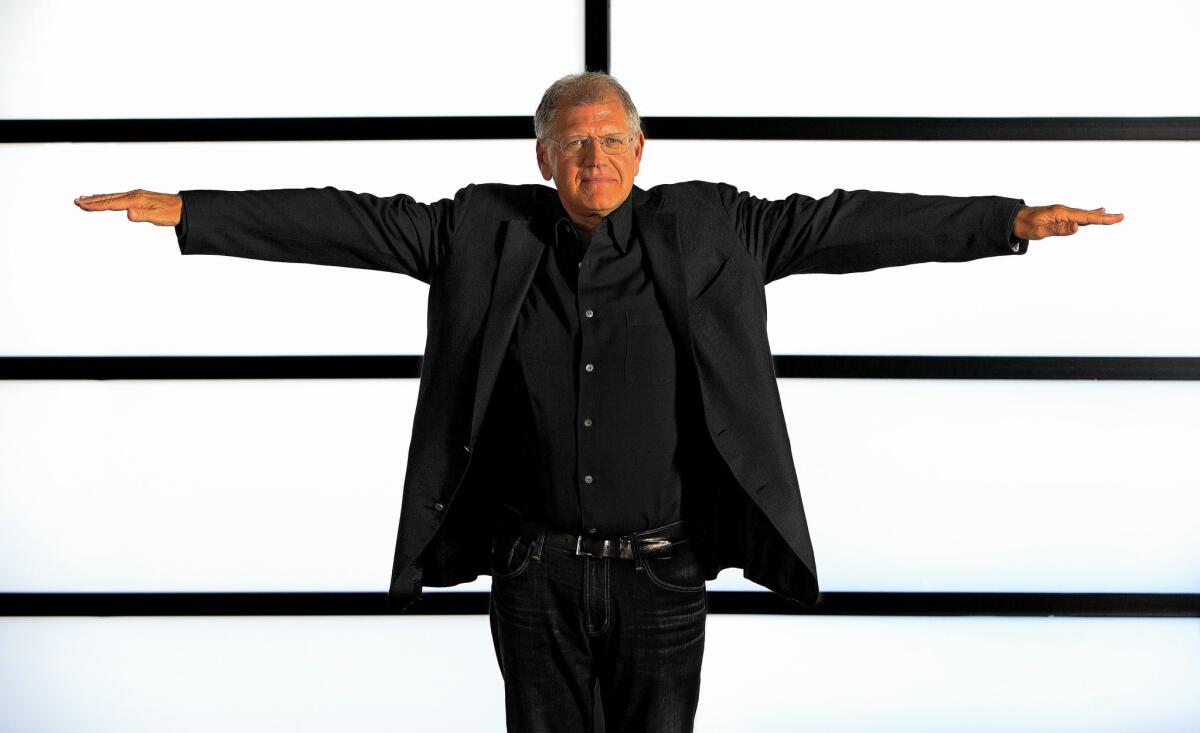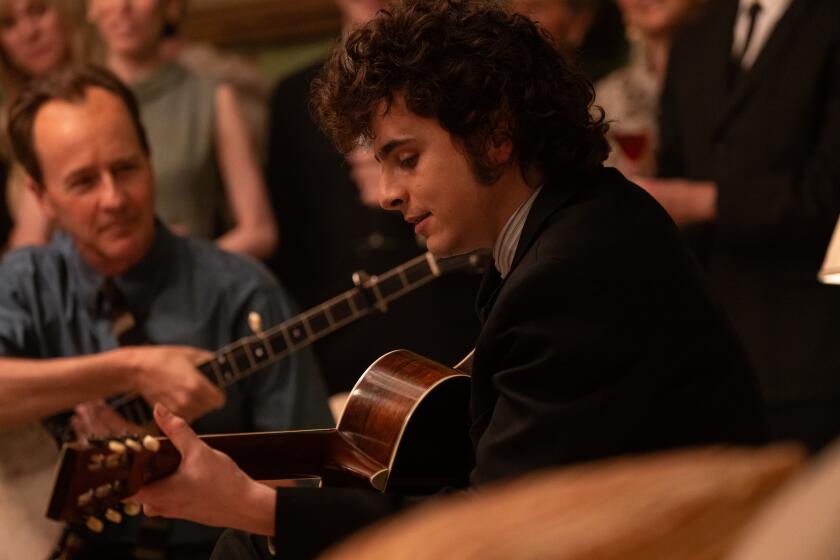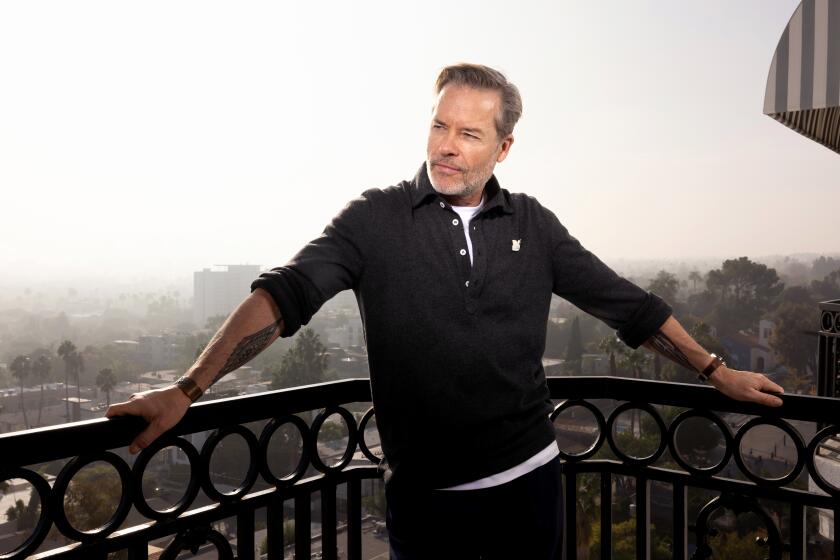Director Robert Zemeckis walks ‘The Walk’ as a quixotic filmmaker

Like a ship’s signal lamp or a backward Beatles album, the movies of the Hollywood filmmaker Robert Zemeckis will throw off a pattern if you pay close enough attention.
Many of them involve a repeating character, a dreamer with a quixotic streak. It’s a person who has a slightly sideways view of the world and the dogged belief that others will soon share it too, if only he’s given the chance to convince them.
Shades of the archetype can be found in Christopher Lloyd’s Doc Brown from “Back to the Future,” in Jodie Foster’s space-gazing Dr. Ellie Arroway from “Contact,” in the group of clever star-seeking young women from his debut, “I Wanna Hold Your Hand,” even in Tom Hanks’ Chuck Noland from “Cast Away.”
SIGN UP for the free Indie Focus movies newsletter >>
And the character can be experienced in full throttle with Joseph Gordon-Levitt’s Philippe Petit, the real-life wire-walker swaggering with ambition both physical and metaphysical in Zemeckis’ new 1970’s-set “The Walk,” which opens in limited release Wednesday. While every seemingly sane person tells Petit he can’t pull off his goal — to walk net-less on a tightrope between the tops of the Twin Towers — the French daredevil pushes on, assembling a ragtag and (slightly) less-skeptical team.
The archetype remains fundamentally similar even as he or she is folded into radically different settings, almost like the hero of “Forrest Gump.” Which is fitting, because that’s a Robert Zemeckis movie too.
It hardly takes a Chuck Noland-degree of ingenuity to decipher why a person like this ends up in a Zemeckis movie: The character is a stand-in for the director himself.
“There is an autobiographical component to everything Bob does,” said Alan Silvestri, the composer who has worked on nearly 20 movies with the director. “The idea of being driven by [passion], by being committed to one’s art even if there’s collateral damage.”
Or as Tom Rothman — the head of “Walk” studio Sony Pictures and both a longtime collaborator of Zemeckis’ and a champion of this material — puts it, “The metaphor is so good it almost seems not true. Bob is Philippe.”
Zemeckis, who resists interpreting his work like Marty McFly rebuffs the advances of an oblivious parent, cops to a certain identification with the archetype. Sort of. Maybe.
“I think I’m the last person who can make that determination,” he said.
The last person? Really?
“I do present a question to my team before every movie: ‘How are we going to do this in a way that hasn’t been seen or done before?,’” he admitted.
Perhaps he could take the comparison somewhat further?
“OK, maybe those characters are in my psyche. There’s probably a little bit of that in me, seeing how far we can work outside the envelope and still make the ultimate finished product accessible.”
Much exists outside the envelope for Philippe Petit. Or, more accurately, above it. When “The Walk” makes its premiere at opening night of the New York Film Festival on Saturday, it will take viewers to literal new heights.
Petit, as fans of the 2009 Oscar winner for best documentary, “Man on Wire,” will recall, was a brash and talkative young French street performer. Cast out by confounded parents, he begins exploring ways to dazzle audiences with feats only the deluded would attempt, particularly those featuring public spaces, heights and thin wires. (One early effort involves the air over Notre Dame.) Soon he’s upping the architectural-landmark ante.
Browsing a magazine, Petit comes upon the under-construction World Trade Center in New York. In a flash he’s off to the States, assembling a team for a gonzo mission that will allow him to sneak up to the roof--and, through a series of clever work-arounds, affix a wire 110 stories high for him to walk between the buildings.
Though a whimsically shot character study of a man who fervently worships the God of Big Plans — with a heist-movie conceit to boot — the film’s lasting impression is likely to be its final 25 minutes. That’s when Petit attempts the famous walk in all its vertiginous glory, and when viewers get to see the world from Petit’s perspective. That the movie, presented in Imax 3-D, was made for about $35 million (in Montreal, with a bevy of Zemeckis’ trademark effects trickery) will only, well, heighten the feat.
It will also continue Zemeckis’ run as the most improbable of mainstream filmmakers. At 63, the Chicago native has remained prolific despite reaching an age when many of his contemporaries have slowed down; he’s released seven studio features in the last 15 years, all while steering away from the franchise films that now dominate major companies’ slates.
As with a select few directors — James Cameron, past collaborator Steven Spielberg — he has a sensibility that seamlessly combines art and entertainment, a great populist in a time when movies are rigidly separated into popcorn and vegetables. (His willingness to discuss his work mostly in technical and not thematic terms also harks back to old-school figures like Hitchcock and Eastwood, born of a similar reticence.)
Most notably, Zemeckis has faced his fair share of arrows: of an industry that has sometimes remained unpersuaded; of fans who wondered about his recent perambulations (particularly his detour to three films made in motion-capture, a technology he embraced with Petit-like zeal beginning with “The Polar Express” in 2004); and, significantly, of critics who either think he relies too much on technology or continue to see him as a shiny commercial filmmaker with few complex philosophical ambitions.
“A lot of critics take things at face value, and the face value Bob presents is of a happy pop filmmaker,” said Dave Kehr, a longtime critic who, as a curator at New York’s Museum of Modern Art, has organized a retrospective on Zemeckis’ work beginning Tuesday. “But he’s not this guy who’s just eager to feed adolescent fantasy — there’s always a moment where his movies step back and say, ‘Maybe these fantasies are kind of juvenile and destructive,’ a moment where this darker idea is happening.” Kehr paused. “Bob is a smuggler.”
Faith on the windowsill
Before they set out to make “The Walk,” Gordon-Levitt wanted to know what the film was about, in its bones. So he asked Zemeckis. The director, who began developing the movie more than eight years ago, thought for a moment and then, Gordon-Levitt recalled, said to the actor, “‘It’s about putting your faith on the windowsill.’ “Actually he said ‘putting your ... on the windowsill,’” Gordon-Levitt laughed.
“And I loved that he did that. How many filmmakers will tell you that’s what their film is about? How many would say it like that? But that’s Bob. A lot of people who are that intelligent give you all these cues about how intelligent they are, by how they speak or what they say. Bob doesn’t. He ducks under his intelligence.”
Zemeckis — an avid pilot who lives and works in the Santa Barbara area — told Gordon-Levitt to watch the 1970 drama “Patton” to prepare for the role; it would, he hoped, help the actor understand a character who determinedly goes his own way. (Films of a certain classic American vintage are Zemeckis favorites, especially the works of Billy Wilder and Frank Capra.)
Bob Gale, a lifelong friend who wrote the “Back to the Future” movies with Zemeckis, recalls that when they were undergrads studying cinema at USC, “everyone was doing these dark films. And Bob just said, ‘That’s not what I want to be doing.’ He wanted to make movies in Hollywood. Personal movies, but for the studios.”
Needless to say, that combination can take its toll. Paramount threatened to shut down “Forrest Gump” several weeks before shooting for cost reasons. Even more famously, Zemeckis fired Eric Stoltz more than a month into shooting “Back to the Future” and replaced him with Michael J. Fox, rallying his collaborators — including Spielberg — to convince Universal this was a perfectly safe move.
“I think this willingness to pivot comes from Bob flying an airplane,” said Silvestri, also a pilot. “You’re constantly correcting, constantly getting feedback from instruments and your body to find the right direction.”
The course grew most choppy with the motion-capture phase. Before a triumphant return to live-action with “Flight” in 2012, Zemeckis had directed “Beowulf” and “A Christmas Carol,” both of which drew mixed reviews and questions about Zemeckis’ direction, while also creating a studio of young animators to work on motion-capture films. Then, during a regime change at Disney, the effort abruptly ended.
“I think his lowest professional point came when we had to take 400 talented people we had hired and tell them it was over,” said Jack Rapke, who began as Zemeckis’ agent and has long served as his producing partner. “We went to a lot of dark places. I remember Bob saying, ‘Is it over? Is the pain and suffering worth continuing for? I really don’t have to do this anymore, so why bother?’ But ultimately he decided this is who he is.”
Zemeckis, whose next movie is a live-action WWII romance with Brad Pitt and Marion Cotillard (he says that far from abandoning motion-capture, he may return to it as the technology improves), has an equally existential explanation for carrying on.
“I kind of go to — what’s the best way to describe it? — like a white-out state when I feel I need to make a movie. Nothing can stop me. It sounds arrogant, but it’s not. It’s like Philippe — it just happens in my gut.”
Road to ‘The Walk’
Zemeckis has made a strikingly wide range of movies across a topography so varied it scarcely seems to come from the same person--films that, if they’re united by anything, it’s just a strong sense of story.
Yet for all the disparateness of his resume, “The Walk” is perhaps the work that brings it all together. There are many numerous Zemeckis touchstones: friends coming to New York to make it (“I Wanna Hold Your Hand”), a crazy, soul-saving scheme (“Back to the Future,” Petit is even stringing a wire with life-and-death urgency, Doc Brown style), the undercurrent of isolation inherent (“Cast Away,” “Who Framed Roger Rabbit?” and others), the potent visual of objects or people falling (the feathers of “Forrest Gump,” the plane in “Flight”).
And there is, as with so many of his movies, a sense of sheer entertainment, so much so that it can take some time or a repeat viewing before the more substantive layers become apparent.
“Francois Truffaut said that a really good movie is a perfect blend of truth and spectacle, and I’ve always subscribed to that,” Zemeckis said. “Movies have to do two things: they have to entertain you, in whatever way that is, and they have to speak to some human dilemma or some human truth. Those are the movies I like and those are the movies I want to make.”
“The Walk” ends with surprising melancholy, one that belies Zemeckis’ reputation as a pop artist. For all the ways we achieve of our dreams, the movie suggests, life is fleeting, and any insistence on forever is an abstraction at best.
How obviously Zemeckis wants this message absorbed — or how much he’s steered to it by his own life — is hard to say. He has admitted that the stress of Hollywood filmmaking took a toll on his sense of self as well as his first marriage to actress Mary Ellen Trainor, with whom he had a son. Rapke said that “Bob is now in a good place, a very good place,” married with three children to the former Leslie Harter. Still, Trainor died this year, and friends say it affected him.
It would be hard to gain clarity on the issue from Zemeckis, who rarely speaks directly on these matters.
“I think it’s a Midwest thing,” said Kehr, who is also from the region and first met Zemeckis in the early 1990s. “You don’t talk about certain things. You just put it into something else, which in this case is the screen.”
Zemeckis agreed that connections between feelings and films can be difficult for him to ascertain.
“I don’t know. I really don’t know. It’s like asking a painter why he paints what he does,” he said. “Before I make a movie, I can only say, ‘This is a movie I really want to see.’ And that’s what makes it personal.”
MORE:
Box office time machine: No. 1 films from 10, 20 and 30 years ago
Filmmakers tackling social issues keep it real but also entertaining
More to Read
Only good movies
Get the Indie Focus newsletter, Mark Olsen's weekly guide to the world of cinema.
You may occasionally receive promotional content from the Los Angeles Times.











